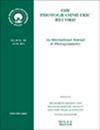THE USE OF SYNTHETIC APERTURE RADAR FOR MAPPING
IF 2.1
3区 地球科学
Q2 GEOGRAPHY, PHYSICAL
引用次数: 7
Abstract
There is a growing interest in the potential of synthetic aperture radar (SAR) for mapping and for gathering intelligence for map revision. This paper first gives a simple guide to the characteristics of SAR and then describes a study carried out to investigate the geometric properties of the imagery and the information content which is of interest for topographic mapping and the production of large scale plans. The conclusions cautiously indicate a potential although better quality images are required and more information must be known about the optimum conditions which should obtain when the data are recorded. Resume On assiste a un interet croissant envers le radar a ouverture synthetique (SAR) et ses possibilityes pour la cartographie et pour la collecte de renseignements utiles a la revision. Ce texte commence par donner un simple rappel des caracteristiques de ces radars pour decrire ensuite une etude effectuee sur le contenu informatif et les proprietyes geometriques de l'imagerie radar, qui interesse la cartographie topographique et la confection de plans a grande echelle. Les conclusions font prudemment etat d'une potentialite mais soulignent qu'il faudrait disposer d'images de meilleure qualitye et avoir davantage d'informations sur les conditions optimales a respecter lors de l'enregistrement des donnees. Zusammenfassung Es besteht zunehmendes Interesse an den Moglichkeiten von Radaraufnahmen mittels synthetischer Apertur (SAR) zur Kartenherstellung und Erfassung von Daten zur Laufendhaltung. Zunachst wird im Artikel eine einfache Einfuhrung in die SAR-Charakteristika gegeben. Dann erfolgt eine Beschreibung eines Versuches zur Untersuchung der geometrischen Eigenschaften und des Informationsgehalts, der von Interesse fur die Herstellung topographischer und grossmassstabiger Karten ist. Vorsichtige Schlussfolgerungen ergeben Moglichkeiten zur Verwendung solcher Informationen, wobeijedoch eine bessere Bildqualitat zu fordern ist. Auch mussen noch mehr Kenntnisse uber die optimalen Bedingungen bezuglich der Datenregistrierung bestehen.利用合成孔径雷达进行制图
人们对合成孔径雷达用于制图和为修订地图收集情报的潜力越来越感兴趣。本文首先简单介绍了SAR的特点,然后介绍了一项研究,旨在研究SAR图像的几何特性和信息内容,这对地形测绘和大比例尺平面图的制作有重要意义。结论谨慎地表明,尽管需要更好的质量的图像和更多的信息必须知道的最佳条件下,应该获得的数据记录的潜力。在协助一个非互联网的可转换的环境,如雷达和合成孔径雷达(SAR),并提供可能性,以提供制图,并提供收集的资源,实用程序和修订。Ce对于我开始par唐纳联合国简单的绕绳下降des的特性de ces雷达倒描写一个套间预见练习曲effectuee苏尔le contenu informatif et les礼节在de l 'imagerie雷达,感兴趣的,la cartographie topographique等甜点de la计划grande中阶梯光栅。研究结果表明,在不同的条件下,潜在的主要特征是图像的处理、图像的质量、信息的优势,而在不同的条件下,信息的优势更明显。与此同时,研究人员还发现,合成孔径(SAR)是一种新型的光学合成孔径(SAR)。本文介绍了一种新型的激光激光成像技术。在此基础上,对几何特征和信息特征进行了研究,并对地形学家和大杀人犯进行了研究。(1)信息技术的发展与发展,信息技术的发展与发展,信息技术的发展。每一个人都知道,肯尼迪是最好的,因为他是最好的。
本文章由计算机程序翻译,如有差异,请以英文原文为准。
求助全文
约1分钟内获得全文
求助全文
来源期刊

Photogrammetric Record
地学-成像科学与照相技术
CiteScore
3.60
自引率
25.00%
发文量
71
审稿时长
>12 weeks
期刊介绍:
The Photogrammetric Record is an international journal containing original, independently and rapidly refereed articles that reflect modern advancements in photogrammetry, 3D imaging, computer vision, and other related non-contact fields. All aspects of the measurement workflow are relevant, from sensor characterisation and modelling, data acquisition, processing algorithms and product generation, to novel applications. The journal provides a record of new research which will contribute both to the advancement of photogrammetric knowledge and to the application of techniques in novel ways. It also seeks to stimulate debate though correspondence, and carries reviews of recent literature from the wider geomatics discipline.
Relevant topics include, but are not restricted to:
- Photogrammetric sensor calibration and characterisation
- Laser scanning (lidar)
- Image and 3D sensor technology (e.g. range cameras, natural user interface systems)
- Photogrammetric aspects of image processing (e.g. radiometric methods, feature extraction, image matching and scene classification)
- Mobile mapping and unmanned vehicular systems (UVS; UAVs)
- Registration and orientation
- Data fusion and integration of 3D and 2D datasets
- Point cloud processing
- 3D modelling and reconstruction
- Algorithms and novel software
- Visualisation and virtual reality
- Terrain/object modelling and photogrammetric product generation
- Geometric sensor models
- Databases and structures for imaging and 3D modelling
- Standards and best practice for data acquisition and storage
- Change detection and monitoring, and sequence analysis
 求助内容:
求助内容: 应助结果提醒方式:
应助结果提醒方式:


